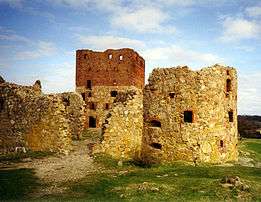Hammershus

Hammershus is Scandinavia's largest medieval fortification, situated 74 metres (243 ft) above sea level on Hammeren, the northern tip of the Danish island of Bornholm in the Baltic Sea. Erected in the 13th century, it was long believed that the castle was built as a private residence for the archbishop of Lund. However, new evidence found at the ruins of the castle suggests it was constructed in the beginning of the century as a royal residence for Valdemar II of Denmark and a base for the Danish crusades, according to Kjeld Borch Westh, superintendent of the National Museum of Denmark.
The fortification consists of the base castle residence and accompanying Mantel Tower, and includes a great stonewall stretching 750 metres (2,460 ft) around the castle grounds. Bricks found at the tower during the renovation led Westh and other experts to revise their theory on when the structure was originally constructed, moving back the date from around 1255 to the beginning of the century, when Valdemar became king.
History



During a number of successive struggles between the kings of Denmark versus the Archbishopric, the fortress, serving as a refuge for the Archbishops, e.g. Jens Grand, was conquered by the king's army on a number of occasions, e.g. 1259, 1265, 1319, and 1325. In 1521, it was taken by king Christian II, who used it to imprison Bishop Jens Andersen Beldenak of Funen. The fortress was conquered by forces of Lübeck the same year.
In 1658, Hammershus was occupied by Swedish forces, but a rebellion on the island terminated the Swedish rule. The rebels, led by Jens Pedersen Kofoed, shot the Swedish commandant Johan Printzenskiöld, and the Danish peasants traveled to Copenhagen to return the island to the king of Denmark. Corfitz Ulfeldt and his wife Leonora Christina were imprisoned in Hammershus 1660–1661, and the fortress was used as a prison on several other occasions.
The fortress was partially demolished around 1750 and is now a ruin. It was partially restored around 1900.
Description
Visitors to Hammershus have a spectacular view of the coastline and the sea surrounding Bornholm. South of the castle is a deep valley, water filled hollows, and dense forest. There are numerous points before arriving at castle where enemies could be stopped. The castle was built with box-like rooms surrounded by rings of fortifications. Each provided an additional layer of protection from invaders. Two natural spring ponds provided fresh drinking water on the side of the castle. Hammershus Fortress features a 750-metre-long (2,460 ft) perimeter wall and features a grand tower called the "mantel" tower.
Hammershus is the largest medieval fortification in Northern Europe.[1]
Art and Kunstmuseum
Because of the unusual pure light on Bornholm and because it has only four hours of darkness in summer, many of Denmark's earliest artists painted spectacular views of Hammerhus. One of the most famous is by Anton Edvard Kieldrup (1827–1869), created in 1849, which is on display at Bornholm's Museum of Art ("Kunstmuseum").
Notes
References
| Wikimedia Commons has media related to Hammershus. |
- Bornholm Tourist Guide; personal visits of author to Hammershus and the "Kunstmuseum".
- This article is partially based on the corresponding articles on the Swedish and German Wikipedias, accessed on July 20, 2006.
Coordinates: 55°16′15″N 14°45′18″E / 55.27083°N 14.75500°E
| ||||||||||||||||||||||||||||||||||||||||||||||
